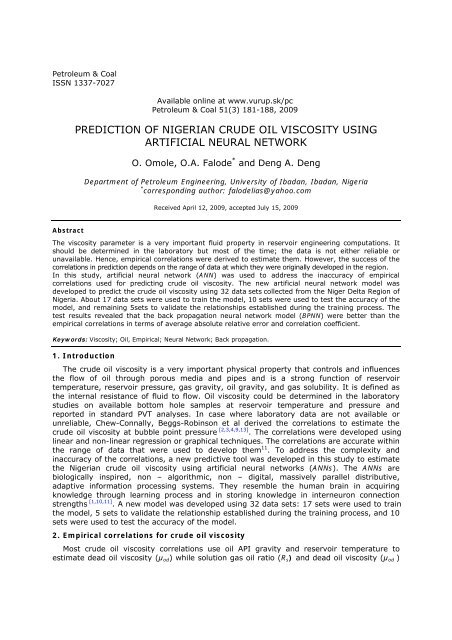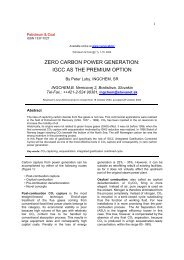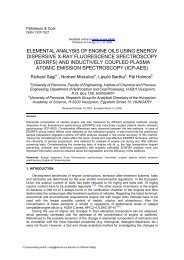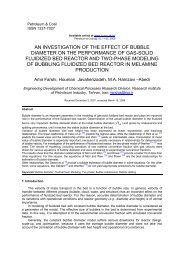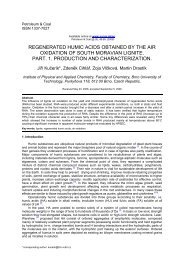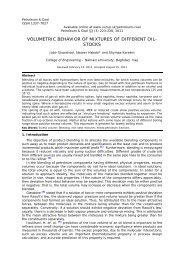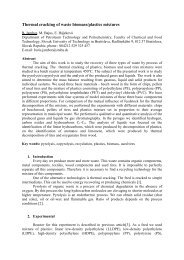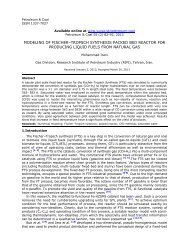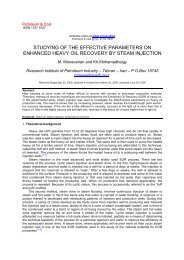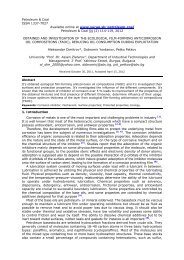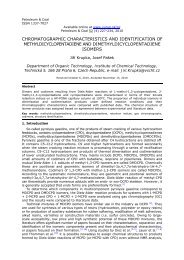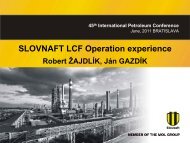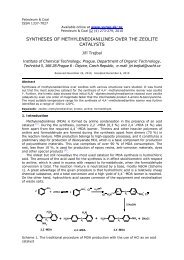prediction of nigerian crude oil viscosity using artificial neural network
prediction of nigerian crude oil viscosity using artificial neural network
prediction of nigerian crude oil viscosity using artificial neural network
Create successful ePaper yourself
Turn your PDF publications into a flip-book with our unique Google optimized e-Paper software.
Petroleum & Coal<br />
ISSN 1337-7027<br />
Available online at www.vurup.sk/pc<br />
Petroleum & Coal 51(3) 181-188, 2009<br />
PREDICTION OF NIGERIAN CRUDE OIL VISCOSITY USING<br />
ARTIFICIAL NEURAL NETWORK<br />
O. Omole, O.A. Falode * and Deng A. Deng<br />
Department <strong>of</strong> Petroleum Engineering, University <strong>of</strong> Ibadan, Ibadan, Nigeria<br />
* corresponding author: falodelias@yahoo.com<br />
Received April 12, 2009, accepted July 15, 2009<br />
Abstract<br />
The <strong>viscosity</strong> parameter is a very important fluid property in reservoir engineering computations. It<br />
should be determined in the laboratory but most <strong>of</strong> the time; the data is not either reliable or<br />
unavailable. Hence, empirical correlations were derived to estimate them. However, the success <strong>of</strong> the<br />
correlations in <strong>prediction</strong> depends on the range <strong>of</strong> data at which they were originally developed in the region.<br />
In this study, <strong>artificial</strong> <strong>neural</strong> <strong>network</strong> (ANN) was used to address the inaccuracy <strong>of</strong> empirical<br />
correlations used for predicting <strong>crude</strong> <strong>oil</strong> <strong>viscosity</strong>. The new <strong>artificial</strong> <strong>neural</strong> <strong>network</strong> model was<br />
developed to predict the <strong>crude</strong> <strong>oil</strong> <strong>viscosity</strong> <strong>using</strong> 32 data sets collected from the Niger Delta Region <strong>of</strong><br />
Nigeria. About 17 data sets were used to train the model, 10 sets were used to test the accuracy <strong>of</strong> the<br />
model, and remaining 5sets to validate the relationships established during the training process. The<br />
test results revealed that the back propagation <strong>neural</strong> <strong>network</strong> model (BPNN) were better than the<br />
empirical correlations in terms <strong>of</strong> average absolute relative error and correlation coefficient.<br />
Keywords: Viscosity; Oil, Empirical; Neural Network; Back propagation.<br />
1. Introduction<br />
The <strong>crude</strong> <strong>oil</strong> <strong>viscosity</strong> is a very important physical property that controls and influences<br />
the flow <strong>of</strong> <strong>oil</strong> through porous media and pipes and is a strong function <strong>of</strong> reservoir<br />
temperature, reservoir pressure, gas gravity, <strong>oil</strong> gravity, and gas solubility. It is defined as<br />
the internal resistance <strong>of</strong> fluid to flow. Oil <strong>viscosity</strong> could be determined in the laboratory<br />
studies on available bottom hole samples at reservoir temperature and pressure and<br />
reported in standard PVT analyses. In case where laboratory data are not available or<br />
unreliable, Chew-Connally, Beggs-Robinson et al derived the correlations to estimate the<br />
<strong>crude</strong> <strong>oil</strong> <strong>viscosity</strong> at bubble point pressure [2,3,4,9,13] . The correlations were developed <strong>using</strong><br />
linear and non-linear regression or graphical techniques. The correlations are accurate within<br />
the range <strong>of</strong> data that were used to develop them 11 . To address the complexity and<br />
inaccuracy <strong>of</strong> the correlations, a new predictive tool was developed in this study to estimate<br />
the Nigerian <strong>crude</strong> <strong>oil</strong> <strong>viscosity</strong> <strong>using</strong> <strong>artificial</strong> <strong>neural</strong> <strong>network</strong>s (ANNs). The ANNs are<br />
biologically inspired, non – algorithmic, non – digital, massively parallel distributive,<br />
adaptive information processing systems. They resemble the human brain in acquiring<br />
knowledge through learning process and in storing knowledge in interneuron connection<br />
strengths [1,10,11] . A new model was developed <strong>using</strong> 32 data sets: 17 sets were used to train<br />
the model, 5 sets to validate the relationship established during the training process, and 10<br />
sets were used to test the accuracy <strong>of</strong> the model.<br />
2. Empirical correlations for <strong>crude</strong> <strong>oil</strong> <strong>viscosity</strong><br />
Most <strong>crude</strong> <strong>oil</strong> <strong>viscosity</strong> correlations use <strong>oil</strong> API gravity and reservoir temperature to<br />
estimate dead <strong>oil</strong> <strong>viscosity</strong> (µ od ) while solution gas <strong>oil</strong> ratio (R s ) and dead <strong>oil</strong> <strong>viscosity</strong> (µ od )
182<br />
are used to estimate saturated <strong>oil</strong> <strong>viscosity</strong> (µ ob ). The saturated <strong>oil</strong> <strong>viscosity</strong> (µ ob ) and<br />
differential pressure above bubble point pressure are then used to predict undersaturated <strong>oil</strong><br />
<strong>viscosity</strong>. Some <strong>of</strong> the studies which were carried out to develop empirical correlations for<br />
the estimation <strong>of</strong> the <strong>crude</strong> <strong>oil</strong> <strong>viscosity</strong> at bubble point are below:<br />
In 1959, Chew- Connally used 457 <strong>crude</strong> <strong>oil</strong> samples to develop a graphical correlation<br />
which was later expressed mathematically by Standing, in 1981, to estimate <strong>oil</strong> saturated<br />
<strong>viscosity</strong>(µ ob ). In 1975, Beggs and Robinson collected 2,073 <strong>crude</strong> <strong>oil</strong> <strong>viscosity</strong> sets to<br />
propose an empirical correlation that estimated the saturated <strong>oil</strong> <strong>viscosity</strong> (µ ob ). The studies<br />
concluded that the performance <strong>of</strong> the correlations suffer outside the range <strong>of</strong> application [4,12,13] .<br />
3. Artificial <strong>neural</strong> <strong>network</strong>s<br />
Boomer et al. [14] and Corpoven et al. [15] defined <strong>artificial</strong> <strong>neural</strong> <strong>network</strong> (ANN) as a<br />
computing system made up <strong>of</strong> a number <strong>of</strong> simple, highly interconnected elements which<br />
process information by its dynamic response to external inputs. Mohagheh et al. [16]<br />
described that ANN is a biologically inspired computing scheme which is an analog, adaptive,<br />
distributive and highly parallel system that has been used in many disciplines and has<br />
proven to have potential in solving problems that require pattern recognition. They resemble<br />
the human brain in acquiring knowledge through learning process and in storing knowledge<br />
in interneuron connection strength [1,5,6,7,8,10] .<br />
The advantages <strong>of</strong> ANN over the conventional correlations are: <strong>neural</strong> <strong>network</strong>s have<br />
large degrees <strong>of</strong> freedom for fitting parameters, and thus, capture the systems’ non-linearity<br />
better than regression methods and they are superior to the regression models in that they<br />
could be further trained and refined when additional data become available and hence<br />
improve their <strong>prediction</strong> accuracy while it is impossible to make any further change in a<br />
linear or non linear regression model as soon as a model development is over [1,7,8,17] In this<br />
study, the back propagation <strong>neural</strong> <strong>network</strong> (BPNN) was used to model the Nigerian <strong>crude</strong><br />
<strong>oil</strong> <strong>viscosity</strong>. The BPNN is multi- layered information flows from the input to the output<br />
through at least one hidden/middle layer. Each layer contain neurons that are connected to<br />
all neurons in the neighboring layers. The connections have numerical values (weights)<br />
associated with them which will be adjusted during the training phase [1,10,12] .<br />
4. Review <strong>of</strong> literature on <strong>artificial</strong> <strong>neural</strong> <strong>network</strong>s model for <strong>crude</strong> <strong>oil</strong> <strong>viscosity</strong><br />
Several papers on <strong>neural</strong> <strong>network</strong>s have been presented to address many problems in the<br />
<strong>oil</strong> industry. Notable among the papers is the work <strong>of</strong> El-Sharkawy [12] who modeled <strong>crude</strong> <strong>oil</strong><br />
<strong>viscosity</strong> with other PVT properties for <strong>oil</strong> and gas systems <strong>using</strong> radial basis function <strong>neural</strong><br />
<strong>network</strong> (RBFNN). However, previous studies [5,6,7,8] on the use <strong>of</strong> back propagation <strong>neural</strong><br />
<strong>network</strong> (BPNN) model to predict PVT <strong>oil</strong> properties do not attempt predicting µ ob . It was<br />
also believed in the same studies that the application <strong>of</strong> <strong>neural</strong> <strong>network</strong>s required the use <strong>of</strong><br />
large number <strong>of</strong> data sets to get the desired results. The present study which aimed at<br />
predicting µ ob by developing back propagation <strong>neural</strong> <strong>network</strong> model (BPNN) has<br />
demonstrated that a reliable ANN model could in fact be developed <strong>using</strong> fewer data sets.<br />
The objectives <strong>of</strong> this study are to develop ANN models for predicting µ ob , evaluate and<br />
compare the accuracy <strong>of</strong> the ANN models to those <strong>of</strong> the empirical correlations.<br />
5. Mathematics <strong>of</strong> back propagation <strong>neural</strong> <strong>network</strong><br />
The benefit <strong>of</strong> the following mathematical derivative is to show us how the back<br />
propagation <strong>neural</strong> <strong>network</strong> (BPNN) works in reality.<br />
From Fig 1, the derivative is conducted between layer (I) and layer (K). Let I p represents the<br />
net input signals to a node (j) in a layer (J) and W ji stands for the weights <strong>of</strong> the connection<br />
from a node (i) in layer (I) to a node (j) in layer (J).<br />
Due to input pattern,X pi , I p is defined as the sum <strong>of</strong> the inputs to a node (j) or neuron (j) in<br />
the middle (hidden) layer (J) as in the shown expression:<br />
I<br />
pj<br />
=<br />
∑ W<br />
ji<br />
* X pi<br />
= net (1)<br />
J
183<br />
Where W ji is the weight <strong>of</strong> the neuron (j) in the middle layer (J) associated with the neuron<br />
(i) in the layer (I), and I pj is the net input <strong>of</strong> the neuron (j) in the layer (J) or input pattern<br />
for the hidden layer, X pi is an input pattern in the input layer (I). Then, the output, O pj, from<br />
a node (j) or neuron (j) in the middle (hidden) layer (J) because <strong>of</strong> input pattern X pi is<br />
defined as:<br />
1<br />
O =<br />
pj<br />
[1 + exp( −Ipj )]<br />
= f (x)<br />
(2)<br />
Similarly, the net input to a node ( n ) or neuron ( n ) in the layer ( K ) due to the input<br />
pattern, X , <strong>of</strong> the input layer ( I ), can be defined as follows:<br />
I<br />
pk<br />
= ∑<br />
k<br />
pi<br />
W<br />
ni<br />
* X pi<br />
= net (3)<br />
Where W<br />
ni<br />
is the weight factor. Hence, the output from a node ( n ) in the output layer ( K )<br />
or layer ( K ) caused by the input pattern, X<br />
pi<br />
, is defined as:<br />
O<br />
pk<br />
=<br />
1<br />
[1 + exp( −Ipk)]<br />
= f (x)<br />
(4)<br />
As soon as the <strong>neural</strong> <strong>network</strong> undergoes the learning processes, the mean square error<br />
criterion ( E ) is defined as a half <strong>of</strong> the sum <strong>of</strong> the squared difference between the actual<br />
outputs <strong>of</strong> output nodes <strong>of</strong> the <strong>network</strong> ( O<br />
pk<br />
) and our desired output ( d<br />
pk<br />
) given as:<br />
E =½ ∑ ( d<br />
pk<br />
- O<br />
pk<br />
) 2 (5)<br />
k<br />
∑<br />
p<br />
Equation (5) is the objective function, which will be minimized during learning iterations or<br />
the minimization <strong>of</strong> the above error depending on weights as reported by Al-Kaabi et al. [18]<br />
and by the Widrow – H<strong>of</strong>f theory as reported by Magali et al. [19] .<br />
Learning is achieved by changing the weights by an incremental value, Δ W ni . This value is<br />
defined as proportional to, E , by:<br />
∂E<br />
ΔWni<br />
= −η *( )<br />
(6)<br />
∂Wni<br />
Applying the chain rule to the right- hand <strong>of</strong> equation (6), we have:<br />
∂E<br />
∂E<br />
∂Opk<br />
∂net<br />
= * *<br />
(7)<br />
∂Wni<br />
∂Opk<br />
∂net<br />
∂Wni<br />
Taking the derivative <strong>of</strong> I<br />
pk<br />
with respect to W<br />
ni<br />
in equation (3), we obtain<br />
∂ Wni<br />
X<br />
pi<br />
∂I<br />
∑ *<br />
pk k<br />
∂net<br />
=<br />
= X<br />
pi<br />
=<br />
(8)<br />
∂Wni<br />
∂Wni<br />
∂Wni<br />
Taking a derivative <strong>of</strong> ( E ) with respect to (O pk ) in equation (5), we have<br />
∂E<br />
= - ( d<br />
pk<br />
− Opk<br />
) (9)<br />
∂O pk<br />
By definition, let δ<br />
pk<br />
represents a local error defined as:<br />
∂E<br />
δ pk = ( ) (10)<br />
∂I pk<br />
Using the chain rule to expand equation (10), we have:<br />
∂E<br />
∂Opk<br />
δ<br />
pk<br />
= * (11)<br />
∂O<br />
∂I<br />
pk<br />
pk
184<br />
From equation (4), taking a derivative <strong>of</strong> O pk with respect to<br />
∂O<br />
∂I<br />
pk<br />
pk<br />
I<br />
pk<br />
, we have:<br />
= f I ) , (12)<br />
( pk<br />
Where the right- hand <strong>of</strong> the above equation is the transfer function <strong>of</strong> our <strong>neural</strong> <strong>network</strong>.<br />
Substituting Equations (8), (9), and (12) into equation (7), we obtain:<br />
Δ = η *(<br />
− ) * ( )<br />
(13)<br />
W d O f I * X<br />
ni<br />
pk<br />
pk<br />
pk<br />
pi<br />
Equation (8) gives the required weight change within a link between a node (i ) in layer J<br />
and a node (n) in the output layer k.<br />
η is usually denoted the learning rate that takes any value between 0 and 1.<br />
A popular modification to increase the learning rate <strong>of</strong> the back propagation algorithm is the<br />
use <strong>of</strong> a momentum term as reported by Al - Kaabi et al. [18] . Hence, the change in the link<br />
or weight with the momentum term can be defined and added as follows:<br />
ΔW ni (n+1) =η* δ<br />
pk<br />
* f ( I<br />
pk<br />
) * X<br />
pi<br />
+α*ΔW ni (n) (14)<br />
Where α takes values between 0 and 1.<br />
Also, the weight change (∆W ij ) between the input layer (I) and hidden layer (J) can be<br />
derived as follows:<br />
The learning <strong>of</strong> the <strong>neural</strong> <strong>network</strong> is accomplished by changing the weight between the<br />
links by the following incremental value ∆W ij , which is defined as follows:<br />
∂E<br />
Δ Wij<br />
= −η *<br />
(15)<br />
∂W<br />
ij<br />
Applying the chain rule in the right- hand side <strong>of</strong> the equation (15), we have<br />
∂E<br />
∂E<br />
∂Opj<br />
∂net<br />
= * *<br />
(16)<br />
∂W<br />
∂O<br />
∂net<br />
∂W<br />
ij<br />
pj<br />
ij<br />
Taking the derivative <strong>of</strong> E with respect to O pj in Equation (5), after replacing the subscript k for j,<br />
we have<br />
∂E<br />
= ( d<br />
pj<br />
− Opj<br />
)<br />
(17)<br />
∂O<br />
pj<br />
Taking the derivative <strong>of</strong> O pj with respect to net or I pj in Equation (2), we have:<br />
∂Opj<br />
= f ( net)<br />
(18)<br />
∂net<br />
Taking a derivative <strong>of</strong> net or I pj with respect to W ij in Equation (1), we get:<br />
∂net<br />
∂∑ Wij * xpi<br />
= = Xpi<br />
(19)<br />
∂Wij<br />
∂Wij<br />
At the hidden layer (J), the local error is equal to the following:<br />
∂E<br />
δ<br />
pj<br />
= * f ( net)<br />
(20)<br />
∂O<br />
pj<br />
From Equations (16), (17), (18), (19), and (20) , we obtain the final results<br />
Δ W<br />
ij<br />
= η *δ<br />
pj<br />
* X<br />
pi<br />
(21)<br />
For the weight update <strong>using</strong> the gradient rule, we find;<br />
W ( n + 1) = W ( n)<br />
+η * δ * X<br />
(22)<br />
ij<br />
ij<br />
6. Data acquisition and analysis<br />
pj<br />
pi<br />
The 32 data sets used in this work were collected from the Niger delta region <strong>of</strong> Nigeria.<br />
The ranges <strong>of</strong> the data are the following: reservoir temperature (154 to 234 o F), <strong>oil</strong> gravity<br />
(19–45.4 o API), solution gas <strong>oil</strong> ratio(210–3100 SCF/BBL), gas gravity(0.690-1.118, air = 1.0),
185<br />
bubble point pressure (1420– 4845 psia), and <strong>crude</strong> <strong>oil</strong> <strong>viscosity</strong> at the bubble point (0.22 - 3.91<br />
centipoise).<br />
Of the 32 data sets, 17 were used to train the ANN models, 5 data sets were used to cross –<br />
validate the relationships established during training process and the remaining 10 data sets were<br />
used to test the ANN models to evaluate their accuracy through statistical analysis.<br />
7. Analysis <strong>of</strong> the results <strong>of</strong> μ<br />
ob<br />
ANN model<br />
A computer simulation program for Nigerian <strong>crude</strong> <strong>oil</strong> <strong>viscosity</strong> model was written in the<br />
C ++ programming language to predict µ ob . Then, the 17 data sets were normalized and used<br />
in the µ ob ANN model as a training file. The model inputs were reservoir temperature,<br />
reservoir pressure, <strong>oil</strong> gravity, gas gravity, and solution gas - <strong>oil</strong> ratio. The output is <strong>crude</strong><br />
<strong>oil</strong> <strong>viscosity</strong> at the bubble point. The learning rates, the momentum factor and the number<br />
<strong>of</strong> iterations were used as training parameters. The computed outputs were compared with<br />
the desired output to compute the error (Equation 5), which was back propagated through<br />
the system ca<strong>using</strong> it to adjust the weights (Equations 13&14), which control the <strong>network</strong>.<br />
Several topologies including the proposed one were examined, but in the long run, the final<br />
result <strong>of</strong> the training phase on the µ ob ANN model converged at (0.01) learning rate and (7)<br />
neurons in the hidden layer. The stability <strong>of</strong> the training phase means the µ ob ANN model<br />
output was very close to their field values. Therefore, the new µ ob ANN model topology becomes<br />
three layers (i.e. one input layer, one hidden layer, and one output layer) as shown in Figure 2.<br />
X p1<br />
i<br />
W<br />
ki<br />
k<br />
P<br />
n<br />
X p2<br />
T<br />
μ<br />
ob<br />
X p3<br />
W ji<br />
j<br />
W<br />
W<br />
O ok<br />
ni<br />
O j<br />
m<br />
Layer (I) Layer(J) Layer (K)<br />
γ<br />
g<br />
API<br />
R<br />
s<br />
Input Layer<br />
Hidden Layer<br />
Output Layer<br />
Fig. 1 One output layer back propagation <strong>neural</strong><br />
<strong>network</strong><br />
Fig. 2 A schematic <strong>of</strong> the achieved <strong>artificial</strong><br />
<strong>neural</strong> <strong>network</strong> topology used for µ ob<br />
As soon as the training process was over, the error <strong>of</strong> our training process was examined<br />
<strong>using</strong> the 5 data sets which were not included in those used for the training phase to cross –<br />
validate the relationship established during training process. It was found out that the errors<br />
<strong>of</strong> the validation phase decreased in the same manner as the training phase progresses,<br />
which indicates that a good relationship was developed. To finally decide whether the<br />
training phase result was good or bad, the remaining 10 data sets that were not seen by the<br />
µ ob ANN model were used to test the model. The result in Table 1 showed that the µ ob ANN<br />
model was able to closely predict the test data.<br />
8. Discussion <strong>of</strong> the results <strong>of</strong> µ ob ANN model<br />
After training the <strong>neural</strong> <strong>network</strong>, the ANN <strong>crude</strong> <strong>oil</strong> <strong>viscosity</strong> model was tested <strong>using</strong> the<br />
testing data. The results were compared with field data and the <strong>prediction</strong>s <strong>of</strong> other<br />
empirical correlations (namely Chew-Connally, and Beggs- Robinson) are shown in Tables 1.<br />
The statistical analysis presented in Table 2 indicates that the average absolute relative<br />
error was 0.06781 for µ ob ANN model, 0.45852 for Chew-Connally correlation, 0.1741 for<br />
Beggs- Robinson correlation. The correlation coefficient was 0.9989 for the µ ob ANN model,<br />
0.9473 for Chew-Connally correlation, 0.9367 for Beggs- Robinson correlation. The fact that<br />
the ANN µ ob model gave the lowest average absolute relative error <strong>of</strong> 0.06781 and the
186<br />
highest correlation coefficient <strong>of</strong> 0.9989 as compared to those obtained <strong>using</strong> other<br />
correlations, clearly demonstrated that the ANN µ ob model were better predictors <strong>of</strong><br />
<strong>viscosity</strong> than all the empirical correlations as graphically illustrated in Figures 1, 2, 3 and 4.<br />
Table 1: The results for the data used for the testing phase <strong>of</strong> μ<br />
ob<br />
mModel<br />
R<br />
s<br />
1042<br />
1119<br />
977<br />
1237<br />
210<br />
3100<br />
1232<br />
1137<br />
1053<br />
950<br />
R Gasgra<br />
s<br />
API P μ μ μ<br />
ob<br />
obnn<br />
obchew − connally<br />
μobbeg−<br />
robinson<br />
219<br />
183<br />
188<br />
180<br />
154<br />
215<br />
216<br />
212<br />
216<br />
214<br />
1.118<br />
0.920<br />
0.870<br />
0.940<br />
0.73<br />
1.048<br />
0.78<br />
0.78<br />
0.91<br />
0.77<br />
19<br />
40.6<br />
39.4<br />
43.4<br />
23.3<br />
45.4<br />
43.8<br />
44.1<br />
38.2<br />
39.8<br />
2951<br />
2736<br />
2858<br />
2655<br />
1680<br />
4340<br />
3963<br />
3710<br />
2965<br />
3614<br />
0.28<br />
0.3<br />
0.3<br />
0.3<br />
3.84<br />
0.15<br />
0.22<br />
0.23<br />
0.29<br />
0.25<br />
1.2<br />
0.28<br />
0.32<br />
0.24<br />
4.71<br />
0.54<br />
0.21<br />
0.22<br />
0.29<br />
0.28<br />
1.03<br />
0.28<br />
0.3<br />
0.24<br />
3.5<br />
0.14<br />
0.21<br />
0.22<br />
0.28<br />
0.27<br />
Table 2: The Statistical Analysis for μ<br />
ob<br />
Model<br />
Correlation Chew-Connally Begg-Robinson Neutral Network<br />
Ave. absolute relative error (E ave ) 0,45852 0,1741 0,06781<br />
Minimum absolute relative error (E min ) 3,8 3,12 0,12532<br />
Maximum absolute relative error<br />
0,225806 0,391304 0,347826<br />
(E max ) correlation coefficient (R 2 )<br />
Fig. 3 Comparison <strong>of</strong> the estimated <strong>crude</strong> <strong>oil</strong><br />
<strong>viscosity</strong> versus experimental <strong>crude</strong> <strong>oil</strong> <strong>viscosity</strong><br />
(µ ob ANN model).<br />
Fig. 4 Comparison <strong>of</strong> the estimated <strong>crude</strong> <strong>oil</strong><br />
<strong>viscosity</strong> versus experimental <strong>crude</strong> <strong>oil</strong> <strong>viscosity</strong><br />
(Chew-Connally correlation).<br />
Fig. 5 Comparison <strong>of</strong> the estimated <strong>crude</strong> <strong>oil</strong><br />
<strong>viscosity</strong> versus experimental <strong>crude</strong> <strong>oil</strong> <strong>viscosity</strong><br />
(Beggs-Robinson correlation).<br />
Fig.6 Comparison <strong>of</strong> different correlation<br />
coefficients for different correlations <strong>of</strong> µ ob
187<br />
9. Conclusion<br />
The newly developed back propagation <strong>neural</strong> <strong>network</strong> (BPNN) model for predicting <strong>crude</strong><br />
<strong>oil</strong> <strong>viscosity</strong> was better than the empirical correlations.<br />
The µ ob ANN model, achieved the lowest average absolute relative error <strong>of</strong> 0.06781 and<br />
the highest correlation coefficient <strong>of</strong> 0.9989 as compared to existing empirical correlations.<br />
From the scatter diagrams for the ANN models and empirical correlations against their<br />
experimental values, the ANN models data points performed better than the existing<br />
empirical correlations.<br />
Nomenclature<br />
PVT Pressure, Volume, Temperature<br />
µ ob Crude <strong>oil</strong> <strong>viscosity</strong> at the bubble point<br />
P b<br />
Bubble point pressure, psia.<br />
R s<br />
Gas solubility, scf/stb<br />
T f<br />
Reservoir temperature, F<br />
API<br />
Oil gravity<br />
γ g (G.G) Gas gravity<br />
γ o<br />
Specific <strong>oil</strong> gravity<br />
E ave<br />
Average absolute relative error<br />
E min Minimum absolute relative error<br />
E max Maximum absolute relative error<br />
ANN Artificial <strong>neural</strong> <strong>network</strong><br />
W ji<br />
Weight between neuron (i) in the layer (I) and neuron (j) in the layer(J)<br />
W ni<br />
Weight between neuron (i) in the layer (J) and neuron (n) in the layer (k)<br />
α<br />
Momentum factor<br />
E<br />
Error<br />
δ<br />
Derivative <strong>of</strong> E with respect to Ipk = Local Error<br />
η<br />
Learning rate constant<br />
BPNN Back propagation <strong>neural</strong> <strong>network</strong><br />
RBFNN Radial basis function <strong>neural</strong> <strong>network</strong><br />
PE<br />
Processing element<br />
X pi<br />
Input pattern in the input layer<br />
Subscript<br />
P, I , J , and K layers<br />
Ji<br />
between layers i and j<br />
Ni<br />
between layers j and k<br />
f k (I pk )<br />
Sigmoid Transfer Function Derivative<br />
Acknowledgement<br />
The authors would like to extend their appreciation to our funding partners, The Petroleum<br />
Technology Development Fund, Nigeria whose contributions made this work possible.<br />
References<br />
[1] Deng, A. Deng:“ Prediction <strong>of</strong> PVT Oil Properties Using Artificial Neural Network”,<br />
M.Sc Thesis, University <strong>of</strong> Ibadan, Department <strong>of</strong> Petroleum Engineering, Ibadan,<br />
Nigeria, April 2007.<br />
[2] Bradley,H.B.: “Petroleum Engineering Handbook” ,SPE ,Richardson.<br />
[3] Tarek, A.H.: “Reservoir Engineering Handbook”, Gulf Publishing Company, Houston<br />
Texas 77252.<br />
[4] Tarek , A.H : “ Hydrocarbon phase Behaviors” , Houston, Gulf Publishing company.<br />
[5] Goda,H.M , Shokir,E.M , Fattah, K.A and Sayyouh,M.H: “Prediction <strong>of</strong> the PVT Data<br />
Using Neural Network Computing Theory” , SPE 85650, August 2003.<br />
[6] Osman,E.A., Abdel-Wahab,O. A and Al-Marhoun,M.A :“Prediction <strong>of</strong> Oil PVT Properties<br />
Using Neural Networks” , SPE 68233, March 2001.
[7] Gharbi,R.B. and Elsharkawy,A.M.:”Universal Neural Network Based Model for<br />
Estimating The PVT Properties <strong>of</strong> Crude Oil Systems”, SPE 38099, 14 – 6 April 1997.<br />
[8] Gharbi,R.B and Elsharkawy,A.M, : “Neural Network Model for Estimating the PVT<br />
Properties <strong>of</strong> Middle East Crude Oils” ,SPE 37695, March 1997.<br />
[9] Hassan, H., Omer, N., Assad, Y. and Kader: “ Reservoir Engineering “ ,Fr SIMA –<br />
Telex 202647, Paris, France.<br />
[10] Omole, O. and Deng, A.Deng: “ Prediction <strong>of</strong> PVT Oil Properties Using Artificial Neural<br />
Network under review” , Journal <strong>of</strong> Canadian Petroleum Technology.<br />
[11] El-Marhoun, M.A, Osman, E.A,:“Using Artificial Neural Networks to develop New PVT<br />
Correlations for Saudia Arabia Crude Oil”, SPE78592, October 2002.<br />
[12] El-Sharkawy, A.M.: “Modeling the Properties <strong>of</strong> Crude Oil and Gas Systems Using RBF<br />
Neural Network” , SPE 49961.<br />
[13] Tarek, A.H,: Reservoir Engineering 2 nd , Gulf Publishing Company, Houston, Texas, 2001.<br />
[14] Boomer, R.J.: “Predicting Production Using a Neural Network (Artificial Intelligence<br />
beats human intelligence)” , SPE 30202 , June 1995.<br />
[15] Briones, M.F., Corpoven, S.A ,Rojas, G.A., Martinez, E.R.:“Application <strong>of</strong> Neural<br />
Network in the Prediction <strong>of</strong> Reservoir Hydrocarbon Mixture Composition from<br />
Production Data”,SPE 28598,September 1994.<br />
[16] Mohaghegh. S. and Ameri:“Artificial Neural Network As A Valuable Tool for Petroleum<br />
Engineer”, SPE 29220, 1995.<br />
[17] Farshad, F.F., Garber, J.D, Lorde ,J.N.:“Prediction temperature pr<strong>of</strong>ile in producing<br />
<strong>oil</strong>s wells <strong>using</strong> <strong>artificial</strong> <strong>neural</strong> <strong>network</strong>s”, material from the web<br />
http://w.w.wemald.library.com.<br />
[18] Al- Kaabi, A.U, Lee, J.W.: “Using Artificial Neural Nets To Identify the Well – Test<br />
interpretation Model” ,SPE 28151 ,September 1993.<br />
[19] Magali R.G , Meireles, Paulo E.M , Almeida, Student Member, IEEE, and Marcelo<br />
Godoy Simoes , Senior Member , IEEE “A Comprehensive Review for Industrial<br />
Applicability <strong>of</strong> Artificial Neural Networks”, Vol.50, 3 June 2003.<br />
188


